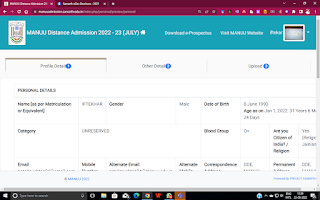Experiments with Samarth implementation at MANUU
What is the Samarth?
SAMARTH is a process automation software for Universities. This also attempts to support other higher education institutes. This is being designed and developed by IIC, University of Delhi.
“An Open Source, Open Standard enabled Robust, Secure, Scalable and Evolutionary Process Automation Engine for Universities and Higher Education Institutions.”
This software covers 9 essential packages, 40+ Samarth Module, 40+ Central Universities are selected for implementation of Samarth. This is a 100% automation engine for Universities.
My role for implementation of Samarth
As a Registrar of Central University Karnataka, I had initiated Samarth implementation in the Universities. It's implementation was also facilitated due to common university test where the students apply using this portal and data is to be imported and used by the user university. However, till I remain in the University, I also insited my colleagues in the university to implement other modules, which gradually started picking up during COVID-19 times when an expert of the field was appointed as Nodal Officer with a support team. As a registrar I sat with agency and ground level functionaries for initiating each of the module.
MANUU and implementation of Samarth
MANUU has started implementation of this project long back before this started at CUK. As this is a huge task few modules were initiated and since MANUU was not yet part of common University Entrance Test the application was invited through IUMS and maintained separately.
On my joining back to DDE and my assignment as Head of the Technical Support Unit of DDE, I started discussions with my team and team support, who supported us easily because of the rapport with them. I had good support from Director, CIT who was the Nodal Officer for implementation of Samarth in MANUU.
We designed the application form in many sitting involving Academic Affairs Unit, Prospectus Committee, RCs, SRCs and various other stakeholders. This required us to put lot of efforts as we had to customise application form by understanding of our requirements and making Samarth understand it, and prepare the project. With limited knowledge of software, requirements, facilities, scope, it was a cumbersome process. We kept bare minimum information in application form, so as to facilitate Urdu candidate who was applying for the first time through online mode and was considered as not well conversant with technology could easily apply online for admission. It was a pleasant surprise to see that about 1500 applicants applied in first phase within 15 days for DDE programmes, which had come to a standstill due to technical reasons. Further, for educating to stakeholders in house meetings were held with faculty, staff and RCs for making student aware of the process and RCs were informed regarding the process of verification of documents.
The second phase of admission was made more interesting by facilitating in-house staff aware of the facilities, scope of Samarth. They were also informed about more facilities in Admission and Academic module by keeping three-week long workshop under the supervision of Samarth Staff. We still depend on CIT, MANUU, Samarth for basic requirements but capacity building of DDE staff has enabled them to set preliminary and important aspects related to admission and academic module.
MANUU admission portal July, 2022
In the following paragraph few merits and shortcoming are being list out for academic benefit.
Advantages of Implementation of Samarth
Implementation of Samarth for admissions and student life cycle is very useful and following are the advantages.
1. The application form was simplified and tailor made to suit requirements of DDE.
2. The unnecessary, redundant, additional information required in the form were removed from the application form or kept as non-mandatory.
3. The form is so simple that the candidate can apply for online programs using his/her mobile in addition to the computer.
4. The online Samarth best admission is divided into three stages namely registration, creation of profile and finally filling of the academic details. Information is saved in each of the stage
5. The application form gives list of LSC to be selected from respective RC for the available programme.
6. There is list of madrasa and respective equivalent qualification and hence the applicant selects appropriately, which was not so earlier when they were typing their madrasa and qualification name.
7. The payment integration is done and hence there is no issue related to collection of amount through DD, deposit, reconcilation, revalidation, etc which was faced by University earlier.
8. In July 2022 session, registration fees is separated from the admission fee, so that more number of students can register for more Programmes and pay the admission fees for only required programmes on verification of documents.
8. The application form is made available to public only after due administrative approval for fixed time and dates are pre fixed which are cannot be altered by any other functionary. This brings discipline in the process of admission. This is an improvement in the prevailing practice.
9. The regional centres are given user credentials and can view the applicants, their credentials in their dashboard of portal. Thus, the verification process can be continued along with admission process. This expedites the process, as there is no postal delay.
10. The entire admission process is carried out in digital format and hence paperless.
Demerits
1. The language used in the application form is simple English and even an Urdu language knowledge seeker can also feel fill the same easily.
2. For the MANUU which has Urdu stakeholders, it is suggested to have Urdu labels in application forms. However, MANUU is in discussion with SAMARTH to incorporate Urdu interface for the learners.
Conclusion
As an academician and administrator, I look at the Samarth implementation as an important aspect in days to come. Every institute has to adapt this. Further, this will also be useful for policy planners to collect the data and devise new schemes in various areas.
Ref:
1. https://samarth.edu.in/pdf/samarth-egov-brochure.pdf




Comments
Post a Comment